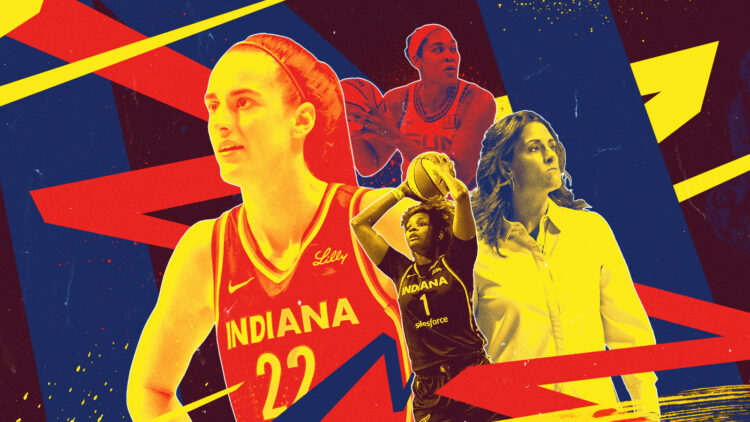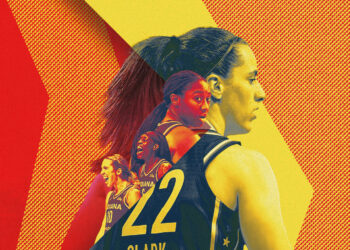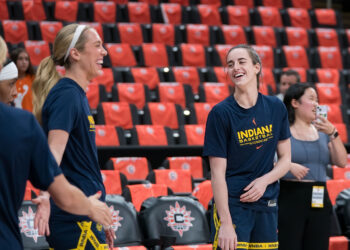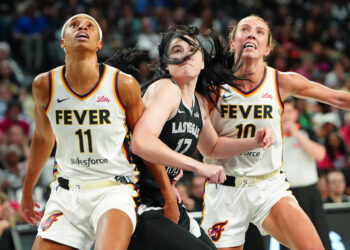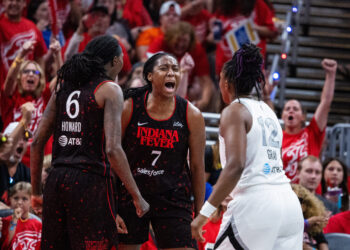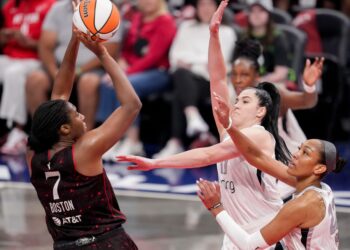The Indiana Fever experienced a season that was surprisingly strong, but ultimately disappointing. They made the playoffs — briefly, of course — before exiting faster than Caitlin Clark’s name was called on draft night. Now, with the golden girl on a budget-friendly contract, the real challenge begins: reshaping the roster and team culture to support her. A talent like hers doesn’t come around every day, and simply handing her the ball and saying “good luck” isn’t a strategy.
The best Fever prospect since Tamika Catchings needs help. In 2024, the consistency varied among certain players, and fumes of team cohesiveness never seemed to stick around. So how, exactly, does this team improve? How do they maximize the window while Clark is young and cheap?
This exercise will probably come across as armchair GM-esque. I understand and won’t try to convince you otherwise. However, I will justify each decision I make, so even if you disagree, you will hopefully understand my perspective. The steps I lay out are relatively in order, and they are strategies I believe will help make this team better than what we saw in 2024. Here’s hoping Amber Cox, Kelly Krauskopf, and Stephanie White are reading this!
Step 1: Do Not Re-sign either UFA
It’s hard to say goodbye to what’s familiar. Erica Wheeler and Kelsey Mitchell, who have played six and seven seasons in Indy, respectively, have earned the fans’ admiration. And it’s time for their combined, expiring $414,154 salaries to find homes elsewhere.
There is an appeal to keeping a player like Wheeler. If she accepts her role as a scorer off the bench, there’s reason to like what she can bring. Yet, the money she might want is better spent elsewhere. This team needs help in numerous places, especially defensively, and her 3.6 points per game (PPG) and 112 defensive rating (DRTG) can be improved fairly easily.
As for Mitchell, some might struggle to understand why they’d let go of a player who has spent her entire career in Indianapolis and averaged a career-high 19.2 PPG. In fact, I believe they’ll likely core her to keep her around. But this is all about maximizing what Clark and this team can become, and unfortunately, Clark and Mitchell’s numbers together don’t show a fit. Clark was worse offensively with Mitchell, but better defensively. Even still, Mitchell’s 114 DRTG and the team’s somewhat better defensive play without Mitchell on the court paint a much dimmer picture.
That’s also without mentioning that, even while it is intended to help her team, Mitchell frequently forces shots out of the team’s offensive rhythm. In their season-ending loss in Game 2 against the Sun, her three-point attempt late in the game was too early in the shot clock, followed by an unforced turnover that contributed to the loss.
Step 2: Trade NaLyssa Smith to the Atlanta Dream for Allisha Gray
Okay, now we’re getting rolling. I admire Smith’s game; it’s a shame that Aliyah Boston and Clark have unintentionally hampered her growth. Entering the season, I had high hopes for what this team could be with their big three, even with the somewhat awkward fit of Boston and Smith in the post together.
However, Smith has not been able to find a comfortable role for herself on this team. In 2024, she averaged career lows in PPG, minutes per game (MPG), rebounds per game (REB), field goal attempts, and assists per game (APG). The challenges she faced finding space and the ball in her hands with Boston last year have only gotten worse with Clark. The numbers with Smith and Clark on the floor? Not good. The numbers with Smith and Boston on the floor? Not good. As a team, only one of the top seven best lineups by offensive rating (ORTG) this year had Smith in it. The best DRTG lineup Smith was a part of is only the sixth-best on the team.
This is not to throw shade at Smith. She’s only 24, and she’s shown enough to demonstrate how good she can be. It’s been a tough fit for her on this roster and it’s time to move her along for a piece that can better fit what Clark needs.
Enter Allisha Gray. The Dream may look at this and say no, thank you, but what they might not see is that Gray is not a great fit for Howard, either. Maybe it was just former head coach Tanisha Wright’s play calling, but Howard and Gray, both immensely talented, never looked all that fluid in playing together this season. Maybe new head coach Karl Smesko wants a look before doing anything. And yet, in the second most minutes together of any pairing from their starting unit, Howard and Gray’s net rating together is the third lowest.
Gray brings something this Indiana team needs more than anything—competent, two-way play, especially in the backcourt. Gray is one of the premier two-way players in the league. She will compensate for the scoring gap Mitchell leaves behind and improve a backcourt unit last in DRTG in 2024.
She also is a dynamic transition player. Of players who played in at least 25 MPG in 2024, Gray was 13th in the percentage of her points on the fast break. For an Indiana team that wants to run with Clark, they finished ninth in percentage of their points on the fast break. Gray fixes that immediately. Her 34.7 percent career three-point shooting adds a spacer to give Clark more breathing room.
This deal gives Smith a fresh start with a franchise that might be looking for a more long-term solution in the frontcourt despite its success in the Tina Charles era. It also allows Gray to contribute to all facets of her game.
Step 3: Trade/Expose the Multi-Year, Protected Deals for Mid-Level Player
If I were a GM, this would be near the top of my rules list: Don’t give mid-level players contracts that lock them in for years and include protections that make it hard to move on if they underperform. This was the problem with Indiana when they signed Katie Lou Samuelson and Damiris Dantas, despite the latter’s success this past season.
With the Golden State Valkyries set to join the league as the 13th team, I would expose Dantas, even though she had some success with Clark. Maybe they can offer Dantas and a pick or two to keep the Valkyries from prying away someone else (unless Cox and Co. are fine with them taking Grace Berger, Kristy Wallace, or possibly Temi Fagbenle). This adds another protected veteran contract the Fever could offer to a UFA and rids the team of the $100,000 overpay.
Step 4: Trade KLS and picks to Washington for Brittney Sykes
Samuelson was a nice story, but an ill-fated signing from the beginning. Her $180,250 contract, even if it’s just through next season, is too much for this type of player. But what if they could bring in another two-way player to provide veteran experience and leadership in the locker room? Something like Samuelson, their 2026 first-round pick, and a pick swap in 2027 for Sykes. Maybe that’s a little much for one guaranteed year of Sykes, but there’s no question regarding the value of a player like Sykes, and what she can bring to Indiana.
Sykes’ offensive skills, particularly her driving ability, complement Gray’s game and create more shooting opportunities for Clark. These players give the offense multiple variations and options that can quickly stretch and confuse defenses. Sykes hasn’t spent much time in the playoffs, so a chance to join an instant contender would have to intrigue her. She also can teach Clark how to lead, and Clark’s presence means Sykes can return to being a secondary or tertiary scorer, something that’s better suited for her talents.
The next Washington Mystics general manager might not love the player that comes back in this deal, but the Mystics need to retool on the fly. Not only would they get valuable draft assets they would covet, but they also get to watch the Samuelson sisters reunited, something that’s sure to invigorate a fanbase, even if only for one season. Washington also receives an extra $15,000 in cap space from the deal.
Step 5: Sign Brionna Jones
Just because Smith didn’t work with Boston doesn’t mean finding a frontcourt pair with her shouldn’t be a priority. This is especially true if they can unload Dantas’ contract on the Valkyries. The Connecticut Sun are likely to core Alyssa Thomas, leaving Jones free to sign with whichever team she chooses. That could very well be the Sun, but Indiana should at least try to add the imposing big.
Given the changing landscape of broadcasting deals and an opt-out clause in the CBA, 2025 will be an interesting year for free agents. Don’t be surprised if most free agents only accept one-year deals. Jones should be no exception. Signing Jones to a, say, $175,000 deal might be slightly below market, but tag that contract with the veteran protection and she just might say yes.
Now yes, Smith and Boston didn’t work, so why would Jones and Boston? Even though Thomas and Boston have very different basketball profiles, they are both bigs who prefer to operate in and around the paint. If a player like Thomas can cramp Jones’ style in the paint and together can still come out on the positive end, why couldn’t Jones and Boston? Coaching differences aside, adding another quality veteran in Jones would solidify the defense and add another scoring layer to a potent Fever attack.
Step 6: Sign Other Locker Room Vets Who Contribute and Improve the Defense, Bench
We are assuming that most free agents will only accept one-year deals, and honestly, that’s fine with me. Indiana should look to add vets who help build important team chemistry, as well as those who can contribute in minutes off the bench.
My thinking goes to players like Myisha Hines-Allen, Kennedy Burke, and Shatori Walker-Kimbrough. Not only will these players bring robust character, but they’ll also make significant contributions on the court, especially defensively. In 2024, Sides’ bench was sixth in MPG, DRTG, and net rating, and seventh in PPG and ORTG. For this team to get over the hump, it needs quantity and quality bench minutes. Adding these vets wouldn’t necessarily cost a ton either, providing the best of all worlds for the new-look Indiana Fever.
The league has announced the 2025 cap at $1,507,100, so even signing all of those players plus the trades, the team finds itself with a full 12-player roster and still has cap space left over. That’s without factoring any of their potential draft picks.
| Player | Salary |
| Caitlin Clark | $78,066 |
| Allisha Gray | $190,000 (protected) |
| Brittney Sykes | $195,000 (protected) |
| Brionna Jones | $175,000 (protected) |
| Aliyah Boston | $83,371 |
| Lexie Hull | $88,261 |
| Grace Berger | $79,999 |
| Kristy Wallace | $80,823 |
| Kennedy Burke | $82,000 |
| Myisha Hines Allen | $100,000 |
| Shatori Walker Kimbrough | $100,000 |
| Temi Fagbenle | $82,000 |
| Total Players: 12 Total Salary: $1,334,520 Cap Space Remaining: $172,590 | |
Numbers courtesy of Her Hoop Stats
This roster has scoring, size, and, most pressing, defenders. This team would surely give fits to any opponent in the league.
Step 7: Coaching Changes
This step is the most critical of all because it doesn’t matter who the players are if the rotations and schemes don’t function.
At times, former head coach Christie Sides was rightfully criticized for her rotations. It was understood that Clark stepping in would require time for jelling. But once Sides found a few pieces that worked, it felt like she neglected anything else and it seemed to hurt the overall team. This is because opposing teams figured out the rotations quickly and there wasn’t any development elsewhere to counter.
What happened to players like Grace Berger, who showed some inconsistent promise in her rookie season? What about Kristy Wallace, who could never find a rhythm this season? Why did Fagbenle get so much time when her lows were detrimental to this team’s ability to succeed?
Maybe a better bench will provide a more balanced approach, and the expectation is that the new front office will do all it can to find that. But this team will be stuck without cleaner rotations that don’t get overworked or predictable.
The team will likely establish new offensive sets with a new head coach. Stephanie White, the incoming head coach, is known for her creative basketball and using off-ball movement to open up offensive execution. The team’s offensive efficiency and creativity should significantly improve if the player personnel changes to maximize Clark’s talents while not sacrificing other options.
Ultimately, the Fever aren’t likely to take drastic action, as I recommend. Still, they will need to make multiple calculated moves to improve within the Clark window and take steps to get closer to a championship.
All stats through the 2024 season. Unless otherwise noted, all stats are courtesy of WNBA.com
